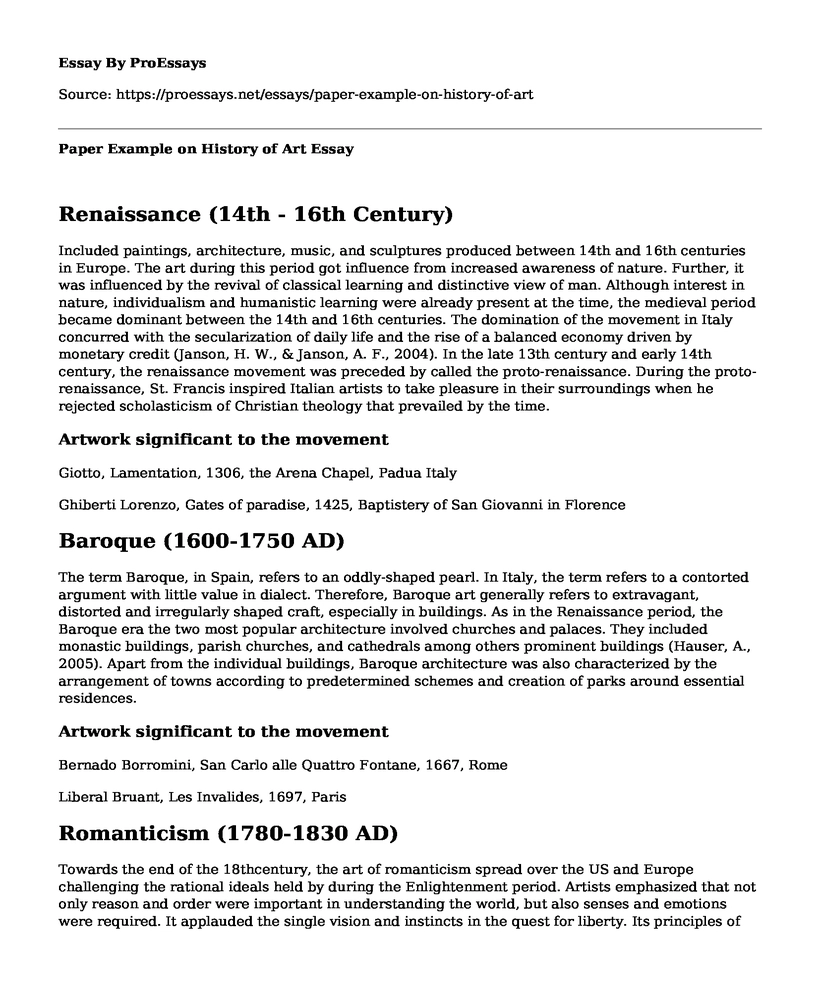Renaissance (14th - 16th Century)
Included paintings, architecture, music, and sculptures produced between 14th and 16th centuries in Europe. The art during this period got influence from increased awareness of nature. Further, it was influenced by the revival of classical learning and distinctive view of man. Although interest in nature, individualism and humanistic learning were already present at the time, the medieval period became dominant between the 14th and 16th centuries. The domination of the movement in Italy concurred with the secularization of daily life and the rise of a balanced economy driven by monetary credit (Janson, H. W., & Janson, A. F., 2004). In the late 13th century and early 14th century, the renaissance movement was preceded by called the proto-renaissance. During the proto-renaissance, St. Francis inspired Italian artists to take pleasure in their surroundings when he rejected scholasticism of Christian theology that prevailed by the time.
Artwork significant to the movement
Giotto, Lamentation, 1306, the Arena Chapel, Padua Italy
Ghiberti Lorenzo, Gates of paradise, 1425, Baptistery of San Giovanni in Florence
Baroque (1600-1750 AD)
The term Baroque, in Spain, refers to an oddly-shaped pearl. In Italy, the term refers to a contorted argument with little value in dialect. Therefore, Baroque art generally refers to extravagant, distorted and irregularly shaped craft, especially in buildings. As in the Renaissance period, the Baroque era the two most popular architecture involved churches and palaces. They included monastic buildings, parish churches, and cathedrals among others prominent buildings (Hauser, A., 2005). Apart from the individual buildings, Baroque architecture was also characterized by the arrangement of towns according to predetermined schemes and creation of parks around essential residences.
Artwork significant to the movement
Bernado Borromini, San Carlo alle Quattro Fontane, 1667, Rome
Liberal Bruant, Les Invalides, 1697, Paris
Romanticism (1780-1830 AD)
Towards the end of the 18thcentury, the art of romanticism spread over the US and Europe challenging the rational ideals held by during the Enlightenment period. Artists emphasized that not only reason and order were important in understanding the world, but also senses and emotions were required. It applauded the single vision and instincts in the quest for liberty. Its principles of imaginative and individual abilities of an artist powered the avant-garde movement into the 20th century (Hauser, A., 2005). Specialists became renown across all genres including writing. The art partly hastened the commitment of the revolution in France and involved the efforts for liberty and justice, and promotion of justice. It adopted the independence and partisanship to reduce the excessive persistence on logical contemplation (Hauser, A., 2005). As a result, artists began to explore their emotional and psychological states and well as their moods.
Artwork significant to the movement
Henry Fuseli, The Nightmare, 1781, London's Royal Academy exhibition
Johan Wolfgang von Goethe, Sorrows of Young Werther, 1774, Germany
Impressionism (1872-1972 AD)
Impressionism can be acknowledged to be the initial modern undertaking in painting. It advanced in France in 1860s and spread through the US and Europe. Its inventors initially disallowed the authorized exhibitions and salons certified by the administration. Consequently, they were shunned by powerful academic art institutions CITATION Jan04 \l 2057 (Janson, H. W., & Janson, A. F., 2004). Unlike their counterpart artists who emphasized the elegant finish and details in art during the time, the impressionist artists purposed to sieze the brief, effect of sense a scene instead. Therefore, numerous of the artists moved to the streets and countryside from the studio.
Artwork significant to the movement
Edouard Manet, Le dejeuner sur I'herbe, 1863, Salon des Refuses
Alfred Sisley, Fog Voisins, 1874, Musee d'Orsay, Paris
Modernism (18th century to current)
The era of modern art came with the start modernization in Western Europe in the mid-19th century, which was pivotal in the history of the world. With the creation and vast accessibility of modern technology such as the combustion engine, huge factories powered by machines and generation of electric power energy in urban regions painters got drawn to new visual landscapes (Hauser, A., 2005). One of the important technologies related closely to modern art is the invention of photography. The technology rapidly advanced, and within a few decades, scenes can be reproduced with perfect accuracy through photographs.
Artwork significant to the movement
Claude Monet, Impression, Sunrise, 1873
Paul Cezanne, The Large Bathers, 1898
References
Hauser, A. (2005). Social History of Art, Volume 4: Naturalism, Impressionism, The Film Age. Abingdon: Routledge.
Janson, H. W., & Janson, A. F. (2004). History of art: the Western tradition. Prentice Hall Professional.
Cite this page
Paper Example on History of Art. (2022, Jun 15). Retrieved from https://proessays.net/essays/paper-example-on-history-of-art
If you are the original author of this essay and no longer wish to have it published on the ProEssays website, please click below to request its removal:
- Postwar California
- Essay Sample on Revolution on the Example of Ottoman Turkey
- John McCosh Photography Essay
- Lazarillo de Tormes and Nueve Reinas Essay
- Research on Industrial Design of Ceramic Products in China
- Monologue of Olive's "Little Miss Sunshine"
- Essay Example on Movie Viewer Preferences for 21 Bridges and Triple 9







